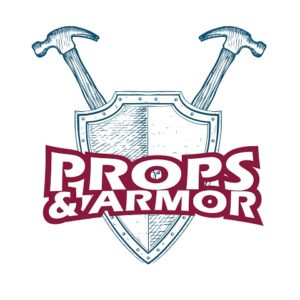Chess has been around for over a thousand years, and throughout its history the pieces have changed shape many times. Originally they were detailed sculptures of people and animals, but in modern times they have a more abstract form. While they were traditionally carved or turned out of natural materials like wood, stone, or ivory, nowadays they can be made much more economically with plastic.
Chess is more popular than ever before, so if you want to make yourself a chess set and you have a 3D printer, you’re in luck. There are many free models available online for chess sets that you can print in just a couple of days. Some of them are modeled after traditional chess sets, and some have a more unique or stylized appearance.
Before we had 3D printing technology, it took a lot of time and skill to produce a chess set. Nowadays you can choose from a wide variety of models and print out the pieces with little effort or skill involved. Of course they won’t match the same quality of a hand crafted chess set, but if you just need some pieces to start playing the game, 3D printing them is a great option. You can even add weights to the pieces to make them heavier, so they feel more substantial.
In this article I’ll go over how you can 3D print your own chess set, how I made mine, and explain many of the other ways that you can go about it. There are actually a lot of options, not only with the different models, but also in the finishing process.
Choosing a Set
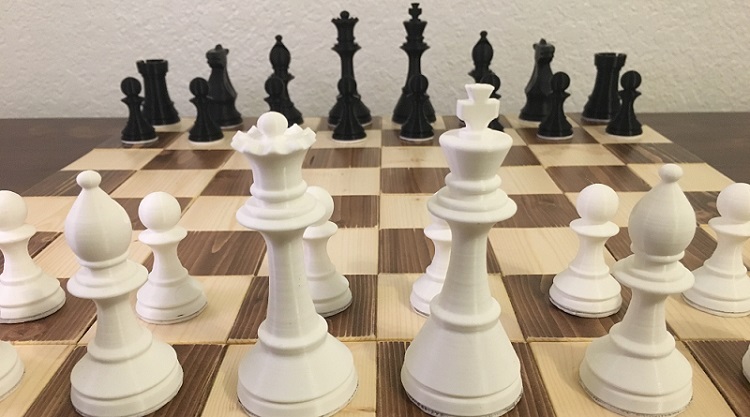
One of the main benefits of 3D printing your own chess set is that you can choose from a variety of unique set designs. If you go to Thingiverse.com and search for “chess set” or even just “chess,” you’ll find over a hundred pages of different models, all available for free. Not all of them are full chess sets, some are just individual pieces, but there’s still plenty to choose from. There are traditional sets, modern designs, and many different themed sets.
If you’re looking for some good traditional sets, I have a few recommendations. The first is the one that I chose to print for myself, which is a Staunton style set modeled by PerryT. This set has a classic look, and can be printed without supports. The only piece that you might want to print with supports is the knight, because the chin of the horse’s head has a steep overhang, but mine printed without too much deformation.
Another good classic set is this Dubrovnik set modeled by kinedix. It can also be printed without supports, according to the designer.
If you’re looking for something a bit more unique, check out this spiral chess set modeled by BigBadBison. It’s one of the most popular, if not the most popular chess set on Thingiverse. The spiral design is very difficult to produce with traditional methods, but simple for 3D printers.
Then there are the themed sets. You can find all kinds of chess sets based on popular TV shows, stories, and movies. One of my favorites is this Pokemon chess set by sch00f. What ever your tastes are, you’ll probably be able to find a themed chess set that appeals to you.
Print Time and Filament Type
Because a full chess set has 32 separate pieces, it can take a long time to print them all out. Of course this will also depend on the size of the pieces, but a full sized chess set can take multiple days to print fully. This might seem like a long time, but even if you ordered a set online, it would probably take at least a few days to ship it to you.
For the set that I printed, which is this full sized Staunton set, the total print time was just over 42 hours. Depending on the size of your printer, you might be able to print all of the pieces for one color at the same time. I decided to print 8 pieces at a time to make it more manageable.
As for what type of filament to use, PLA is fine because the pieces don’t need to be strong. You can print them with thin shells and low infill (around 20 or 15 percent) and they should be fine. They’ll mostly just be sitting on a board or in a box, so they don’t need to handle much stress.
The color of the filament also doesn’t matter so much, because you can always paint the pieces afterwards. Even if you want to smooth them out with one of the methods below, you can still print them in a different color and paint them after the smoothing. So don’t worry if you don’t have enough black and white filament. I actually didn’t have enough black PLA to print all of the black pieces, so I printed the rest in blue PLA and painted them black.
There are even filaments that you can buy that have wood fibers embedded in them. If you want your pieces to feel a bit more like traditional wooden pieces, this might be a good option for you.
Finishing Processes
It’s not 100% necessary to go through any finishing processes for your pieces, but you might want to anyway. You could just print the pieces in the colors that you want, and leave them like that, and they’d be perfectly fine. That’s what I did with most of my pieces. But for those of you who want to smooth out your pieces or paint them, I’ll go over some different methods that you can use.
Tumbling
If you don’t know what a tumbler is, it’s basically a device that spins things around in a container with some other objects inside to smooth them out. They’re used a lot to smooth out rocks, but you can put pretty much anything in them and they will either smooth them out or add texture to them.
You can use tumblers to smooth out 3D printed parts too. Just place your chess pieces inside and let them tumble for a while, and they should come out much smoother. Depending on what you tumble them with, it might not smooth out all of the nooks and crannies, but it should smooth out most of the surface.
Painting
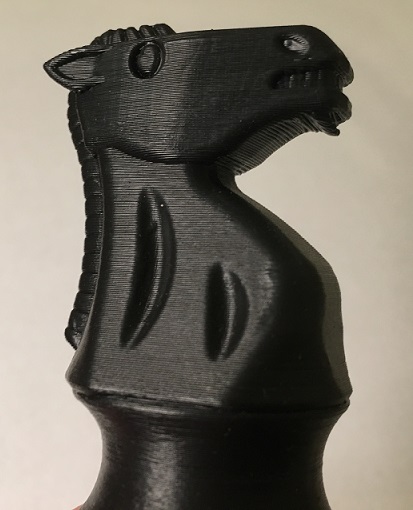
If you didn’t have the exact color of filament that you wanted your pieces to be, then it might be easier just to paint them. With painting you have two options: Hand painting or spray painting. It’s possible to brush some acrylic craft paints directly onto the 3D printed pieces, and that will work well enough. I used this method for some of my black pieces and it worked fine. They did need 2 coats of paint though, because the first coat didn’t completely cover up the blue plastic underneath.
Hand painting with acrylics is fine, but it doesn’t provide a very durable finish. The paint can peel or chip off relatively easily. Spray paint can be much more durable if you apply it properly. If you use a primer first, the paint will stick much better and last longer.
Another benefit of spray painting your pieces is that you can use a filler primer, and that will help to smooth out your pieces somewhat. It might take a few coats, but it will make it much smoother than if you just used normal primer and paint. Normal spray paint doesn’t really fill up cracks or gaps, even with many coats.
Acetone Vapor Smoothing
Acetone vapor smoothing is a technique that can only be used with pieces printed out of ABS or ASA filaments. I haven’t tried it because I don’t print with ABS, because I print indoors and ABS produces toxic fumes as it heats up. But if you have the option to print in a well ventilated area like an open garage, a workshop, or even a patio, then you might want to try printing your chess pieces in ABS and vapor smoothing them, because it can produce very smooth results.
Here’s a good video I found that explains the process.
Adding Weights
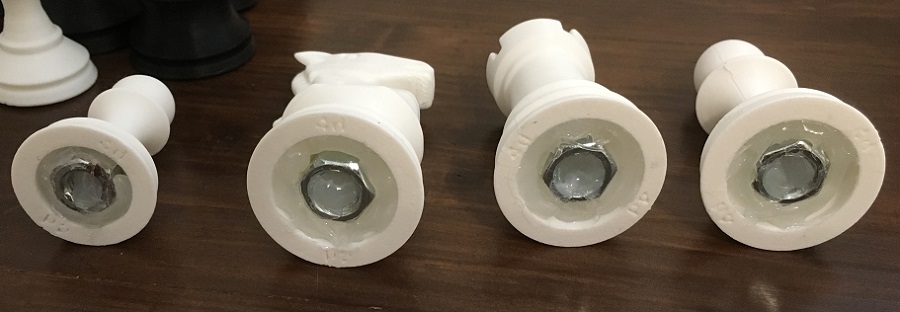
One downside to 3D printed chess pieces is that they’re very lightweight. You could print them with solid infill, but that would take much longer to print and use up a lot more filament. Good quality chess pieces, even ones made out of wood, often have weights added to their bases to make them heavier. You can do the same thing with 3D printed chess pieces.
The set that I printed already came with a hollowed out space in the bottom of each piece, specifically put there by the designer for adding weights. He used lead shot and hot glue, which is a great idea and is probably one of the best ways to add as much weight as possible. If you’re like me though and don’t have any lead shot, then there are other things you can use.
Spare pennies make good weights, if you don’t mind using them. You could also use metal washers. Flat metal pieces are good if the holes in the bottoms of your pieces are cylindrical, but the holes in my set are conical, so smaller bits of metal would work better. I thought about using sand, but I didn’t have any clean sand lying around.
What I did have was a bunch of spare metal hex nuts from an old project. They were small enough to fit into the conical holes, and took up more space than just using washers. I simply placed the hex nuts into the pieces and filled around them with hot glue.
Padding
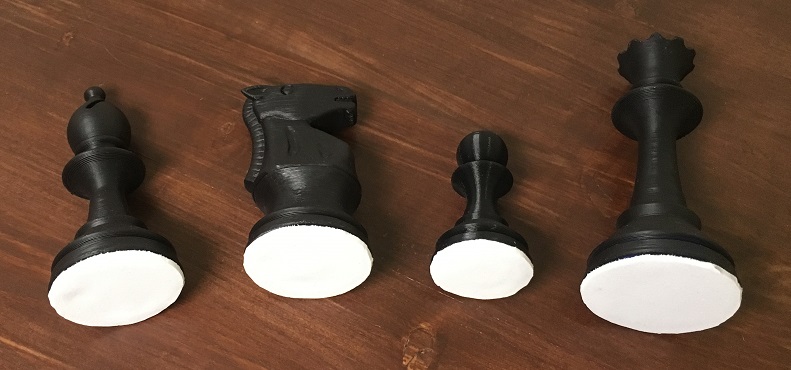
To preserve your chess board, it’s a good idea to add some kind of padding to the bottoms of all the pieces. The bare plastic can dent or scratch the finish on some chess boards. A lot of chess pieces have felt pads, but you could also use foam or even leather. I didn’t have any felt, but I did have some thin craft foam, so I cut out circles and hot glued them to bottom of each piece.
If you decide to use leather, I’d recommend that you put the rough side facing down. This is because the smooth side of leather can sometimes stick to some surfaces. The rough side will usually slide better.
